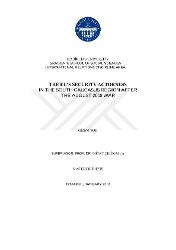| dc.contributor.advisor | Çelikpala, Mitat | en_US |
| dc.contributor.author | Tok, Gizem | |
| dc.date.accessioned | 2020-02-27T17:27:16Z | |
| dc.date.available | 2020-02-27T17:27:16Z | |
| dc.date.issued | 2018 | |
| dc.identifier.uri | https://hdl.handle.net/20.500.12469/2805 | |
| dc.description.abstract | Regionalism has always been in the international era. Regionalism studies has attracted the attention of academics since the end of the Cold War. However, regionalism is divided into two waves as old and new regionalism. The former appeared after the end of World War II (the 1950s) and became influential until 1980s. The latter appeared after end of the Cold War (1980s onwards). There are some distinctions between the two waves of regionalism in terms of the structure, arguments and interest areas. However; there is a transitionary period within them which leads to continuation of mutual characteristics. It is important to evaluate the regionalism approach in historical and world context. After deep evaluation of the regionalism with its two waves; the thesis will explain the Regionalism in the European Union. The new regionalism constitutes the main period which explains the foreign policy relations of the EU with respect to both its internal and external dynamics. The new regionalism approach of the EU provides a coherent framework to understand the EU's neigbourhood policies in the South Caucasus region. This thesis focuses on a specific policy tool and period from the security dimension perspective: The Eastern Partnership Policy and the August 2008 War. The historical background and historical context are taken into consideration in order to analyze the EaP after the end of the August 2008 War. | en_US |
| dc.description.abstract | Bölgeselleşme, uluslararası alanda her zaman var olmasına rağmen; bölgeselleşme çalışmaları akademik anlamda Soğuk Savaş'ın bitmesiyle önem kazanmaya başlamıştır. Bölgeselleşme gelişen akademik çalışmaların sonucunda eski ve yeni olarak iki döneme ayrıldı. Eski bölgeselleşme İkinci Dünya Savaşı'nın bitmesiyle birlikte 1950'li yıllarda ortaya çıkarak 1980'li yılların sonuna kadar etkisini sürdürmüştür. Yeni bölgeselleşmenin ortaya çıkışı ise Soğuk Savaş'ın bitmesinin ardından 1980'li yılların sonuna denk gelmektedir. Eski ve yeni bölgeselleşme kuramları yapısallık, içerik ve dahil ettiği aktörler bazında farklılıklar barındırsa da iki dönem arasında ortak özellikler bulunmaktadır, bu nedenle geçiş dönemini tarihsel çerçeveden ele almak önemlidir. Bu bağlamda eski ve yeni bölgeselleşme kuramlarının detaylı incelenmesi ve karşılaştırılması AB'nin Bölgeselleşme politikalarını anlamak için önemlidir. 1980'li yılların sonundan itibaren Bölgeselleşme politikaları, AB'nin dış politikasını önemli ölçüde şekillendirmiştir. Bu nedenle AB'nin bölgeselleşme politikaları yeni dönemin çerçevesinden ele alınmıştır. AB ve yeni bölgeselleşme yaklaşımı AB'nin Güney Kafkasya Komşuluk politikalarının açıklanması için uygun zemini sağlamaktadır. Bu tez, AB tarafından 2008 Ağustos Savaşı sonrası Güney Kafkasya bölgesinde geliştirilen bölgeselleşme politikalarını güvenlik boyutu açısından incelemektedir. Ayrıca bu tez, AB'nin Doğu Ortaklığı Programı'nı, AB'nin 2008 Savaşı'na verdiği bir güvenlik refleksi olarak görür. | en_US] |
| dc.language.iso | eng | en_US |
| dc.publisher | Kadir Has Üniversitesi | en_US |
| dc.rights | info:eu-repo/semantics/openAccess | en_US |
| dc.subject | Old and New regionalism | en_US |
| dc.subject | Security actorness | en_US |
| dc.subject | Neighbourhood Policies | en_US |
| dc.subject | the EaP | en_US |
| dc.subject | the EU | en_US |
| dc.subject | the South Caucasus region | en_US |
| dc.subject | Eski ve Yeni Bölgeselcilik | en_US |
| dc.subject | Güvenlik Aktörlüğü | en_US |
| dc.subject | Komşuluk Politikası | en_US |
| dc.subject | AB’nin Doğu Ortaklığı Programı | en_US |
| dc.subject | AB | en_US |
| dc.subject | Güney Kafkasya Bölgesi | en_US |
| dc.title | The EU's security actorness in the South Caucasus region after the August 2008 War | en_US |
| dc.type | masterThesis | en_US |
| dc.department | Enstitüler, Lisansüstü Eğitim Enstitüsü, Uluslararası İlişkiler Ana Bilim Dalı | en_US |
| dc.relation.publicationcategory | Tez | en_US |
| dc.identifier.yoktezid | 497284 | en_US |
















